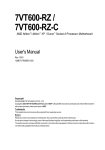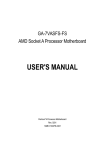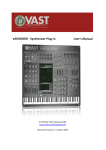Download Gigabyte GA-7VT600 motherboard
Transcript
When you installing AGP card, please make sure the following notice is fully understood and practiced. If your AGP card has "AGP 4X/8X(1.5V) notch"(show below), please make sure your AGP card is AGP 4X/8X(1.5V). AGP 4X/8X notch Caution: AGP 2X(3.3V) card is not supported by VIA® KT600. You might experience system unable to boot up normally. Please insert an AGP 4X/8X(1.5V) card Example 1: Diamond Vipper V770 golden finger is compatible with 2X/4X mode AGP slot. It can be switched between AGP 2X(3.3V) or 4X (1.5V) mode by adjusting the jumper. The factory default for this card is 2X(3.3V). The GA-7VT600(-L) (or any AGP 4X only) motherboards might not function properly, if you install this card without switching the jumper to 4X(1.5V) mode in it. Example 2: Some ATi Rage 128 Pro graphics cards made by "Power Color", the graphics card manufacturer & some SiS 305 cards, their golden finger is compatible with 2X(3.3V)/4X(1.5V) mode AGP slot, but they support 2X(3.3V) only. The GA-7VT600(-L) (or any AGP 4X only) motherboards might not function properly, If you install this card in it. Note : Although Gigabyte's AG32S(G) graphics card is based on ATi Rage 128 Pro chip, the design of AG32S(G) is compliance with AGP 4X(1.5V) specification. Therefore, AG32S (G)will work fine with VIA® KT600 based motherboards. M The author assumes no responsibility for any errors or omissions that may appear in this document nor does the author make a commitment to update the information contained herein. M Third-party brands and names are the property of their respective owners. M Please do not remove any labels on motherboard, thismay void the warranty of this motherboard. M Due to rapid change in technology, some of the specifications might be out of date before publication of this booklet. Declaration of Conformity We, Manufacturer/Importer (full address) G.B.T. Technology Träding GMbH Ausschlager Weg 41, 1F, 20537 Hamburg, Germany declare that the product ( description of the apparatus, system, installation to which it refers) Mother Board GA-7VT600 is in conformity with (reference to the specification under which conformity is declared) in accordance with 89/336 EEC-EMC Directive o EN 55011 o EN 55013 o EN 55014 Limits and methods of measurement o EN 61000-3-2* Disturbances in supply systems cause of radio disturbance characteristics of industrial,scientific and medical (ISM high frequency equipment T EN 60555-2 by household appliances and similar electrical equipment “Harmonics” Limits and methods of measurement o EN 61000-3-3* Disturbances in supply systems cause of radio disturbance characteristics of broadcast receivers and associated equipment T EN 60555-3 by household appliances and similar electrical equipment “Voltage fluctuations” Limits and methods of measurement of radio disturbance characteristics of T EN 50081-1 Generic emission standard Part 1: household electrical appliances, portable tools and similar electrical apparatus o EN 55015 o EN 55020 T EN 55022 o DIN VDE 0855 o part 10 o part 12 Residual commercial and light industry T EN 50082-1 Generic immunity standard Part 1: Limits and methods of measurement of radio disturbance characteristics of fluorescent lamps and luminaries o EN 55081-2 Generic emission standard Part 2: Immunity from radio interference of broadcast receivers and associated equipment o EN 55082-2 Limits and methods of measurement of radio disturbance characteristics of information technology equipment o ENV 55104 Cabled distribution systems; Equipment for receiving and/or distribution from sound and television signals o EN50091-2 Residual commercial and light industry Industrial environment Generic emission standard Part 2: Industrial environment lmmunity requirements for household appliances tools and similar apparatus EMC requirements for uninterruptible power systems (UPS) (EC conformity marking) T CE marking The manufacturer also declares the conformity of above mentioned product with the actual required safety standards in accordance with LVD 73/23 EEC o EN 60065 Safety requirements for mains operated o EN 60950 electronic and related apparatus for household and similar general use o EN 60335 Safety of household and similar electrical appliances Safety for information technology equipment including electrical bussiness equipment o EN 50091-1 General and Safety requirments for uninterruptible power systems (UPS) Manufacturer/Importer Signature: (Stamp) Date :June 2, 2003 Name: Timmy Huang Timmy Huang DECLARATION OF CONFORMITY Per FCC Part 2 Section 2.1077(a) Responsible PartName: Address: G.B.T. INC. (U.S.A.) 17358 Railroad Street City of Industry, CA 91748 Phone/Fax No: (818) 854-9338/ (818) 854-9339 hereby declares that the product Product Name: Motherboard Model Number:GA-7VT600 Conforms to the following specifications: FCC Part 15, Subpart B, Section 15.107(a) and Section 15.109 (a),Class B Digital Device Supplementary Information: This device complies with part 15 of the FCC Rules. Operation is subject to the following two conditions: (1) This device may not cause harmful and (2) this device must accept any inference received, including that may cause undesired operation. Representative Person’s Name: ERIC LU Signature: Eric Lu Date: June 2 ,2003 GA-7VT600(-L) AMD Socket A Processor Motherboard USER'S MANUAL AMD Athlon™/ Athlon™ XP / Duron™ Socket A Processor Motherboard Rev. 1001 12ME-7VT600-1001 English Table of Content Item Checklist ......................................................................................... 4 WARNING! ............................................................................................... 4 Chapter 1 Introduction ............................................................................. 5 Features Summary ...................................................................................... 5 GA-7VT600(-L) Motherboard Layout .......................................................... 7 Block Diagram ............................................................................................. 8 Chapter 2 Hardware Installation Process ................................................ 9 Step 1: Install the Central Processing Unit (CPU) ..................................... 10 Step1-1: CPU Speed Setup ............................................................................................ 10 Step1-2: CPU Installation ................................................................................................. 11 Step1-3:CPU Heat Sink Installation ................................................................................ 12 Step 2: Install memory modules ................................................................ 13 Step 3: Install expansion cards ................................................................. 15 Step 4: Connect ribbon cables, cabinet wires, and power supply ........... 16 Step4-1:I/O Back Panel Introduction .............................................................................. 16 Step4-2: Connectors Introduction ................................................................................... 18 Chapter 3 BIOS Setup .......................................................................... 31 The Main Menu (For example: BIOS Ver. :E1) ......................................... 32 Standard CMOS Features ......................................................................... 34 Advanced BIOS Features .......................................................................... 37 Integrated Peripherals .............................................................................. 39 GA-7VT600(-L) Motherboard -2- PnP/PCI Configurations ............................................................................. 46 PC Health Status ........................................................................................ 47 Frequency/Voltage Control ........................................................................ 49 Load Fail-Safe Defaults ............................................................................. 51 Load Optimized Defaults ........................................................................... 52 Set Supervisor/User Password .................................................................. 53 Save & Exit Setup ....................................................................................... 54 Exit Without Saving ................................................................................... 55 Chapter 4 Technical Reference ............................................................ 57 BIOS Flash Procedure .............................................................................. 57 @ BIOS Introduction .................................................................................. 61 Easy TuneTM 4 Introduction ....................................................................... 62 2-/4-/6-Channel Audio Function Introduction ........................................ 63 Jack-Sensing Introuction ........................................................................... 69 Chapter 5 Appendix .............................................................................. 73 -3- Table of Content English Power Management Setup ....................................................................... 43 English Item Checklist þ The GA-7VT600(-L) motherboard þ 2 Port USB Cable x 1 þ þ þ o o o o o IDE cable x 2/ Floppy cable x 1 Motherboard Settings Label The GA-7VT600(-L) user's manual RAID Manual þ CD for motherboard driver & utility (Driver CD) þ Quick PC Installation Guide 4 Port USB Cable x 1 Audio combo Kit x1 IEEE 1394 Cable x1 SPDIF KIT x1 (SPD Kit) þ I/O Shield WARNING! Computer motherboards and expansion cards contain very delicate Integrated Circuit (IC) chips. To protect them against damage from static electricity, you should follow some precautions whenever you work on your computer. 1. Unplug your computer when working on the inside. 2. Use a grounded wrist strap before handling computer components. If you do not have one, touch both of your hands to a safely grounded object or to a metal object, such as 3. 4. 5. the power supply case. Hold components by the edges and try not touch the IC chips, leads or connectors, or other components. Place components on a grounded antistatic pad or on the bag that came with the components whenever the components are separated from the system. Ensure that the ATX power supply is switched off before you plug in or remove the ATX power connector on the motherboard. Installing the motherboard to the chassis… If the motherboard has mounting holes, but they don’t line up with the holes on the base and there are no slots to attach the spacers, do not become alarmed you can still attach the spacers to the mounting holes. Just cut the bottom portion of the spacers (the spacer may be a little hard to cut off, so be careful of your hands). In this way you can still attach the motherboard to the base without worrying about short circuits. Sometimes you may need to use the plastic springs to isolate the screw from the motherboard PCB surface, because the circuit wire may be near by the hole. Be careful, don’t let the screw contact any printed circuit write or parts on the PCB that are near the fixing hole, otherwise it may damage the board or cause board malfunctioning. GA-7VT600(-L) Motherboard -4- Features Summary Form Factor CPU On-Board IDE On-Board Peripherals Hardware Monitor Chipset Memory I/O Control Slots 29.5cm x 20.0cm ATX size form factor, 4 layers PCB. Socket A processor AMD AthlonTM/AthlonTM XP/ DuronTM (K7) 128K L1 & 256K/64K L2 cache on die 200/266/333/400 MHz FSB and DDR bus speeds Supports 1.4GHz and faster VIA KT600 Memory/AGP/PCI Controller (PAC) VIA VT8235 / VT2837 Integrated Peripheral Controller (PSIPC) 3 184-pin DDR sockets Supports DDR DRAM PC2100/PC2700/PC3200 Supports up to 3.0GB DDR (Max) Supports only 2.5V DDR DIMM IT8705 1 AGP slot supports 8X/4X mode(1.5V) & AGP 3.0 Compliant 5 PCI slots supports 33MHz & PCI 2.2 compliant 2 IDE controllers provides IDE HDD/CD-ROM (IDE1, IDE2) with PIO, Bus Master (Ultra DMA33/ATA66/ATA100/ATA133) operation modes. 1 Floppy port supports 2 FDD with 360K, 720K,1.2M, 1.44M and 2.88M bytes. 1 Parallel port supports Normal/EPP/ECP mode 2 Serial port (COMA & COMB) 6 x USB 2.0/1.1 (4 by cable) CPU/System Fan Revolution detect CPU/System temperature detect System Voltage Detect Thermal shutdown function to be continued...... -5- Introduction English Chapter 1 Introduction English On-Board Sound On-Board USB 2.0 On-Board LAN * PS/2 Connector BIOS Additional Features Overclocking Realtek ALC655 CODEC Line Out / 2 front speaker Line In / 2 rear speaker(by s/w switch) Mic In / center& subwoofer(by s/w switch) SPDIF Out /SPDIF In CD In / AUX In / Game port Built in VIA VT8235 / VT8237 Chipset RealTek RTL8101L 1 RJ45 port PS/2 Keyboard interface and PS/2 Mouse interace Licensed Award BIOS, 2M bit flash ROM Supports Q-Flash PS/2 Keyboard power on by password,PS/2 Mouse power on External Modem wake up STR(Suspend-To-RAM) AC Recovery Poly fuse for keyboard over-current protection USB KB/Mouse wake up from S3 Supports @BIOS Supports EasyTune 4 Over Voltage (CPU/AGP/DDR) by BIOS Over Clock (CPU/AGP/DDR/PCI) by BIOS " * " FOR GA-7VT600-L Only. Please set the CPU host frequency in accordance with your processor’s specifications. We don’t recommend you to set the system bus frequency over the CPU’s specification because these specific bus frequencies are not the standard specifications for CPU, chipset and most of the peripherals. Whether your system can run under these specific bus frequencies properly will depend on your hardware configurations, including CPU, Chipsets,SDRAM,Cards….etc. GA-7VT600(-L) Motherboard -6- English GA-7VT600(-L) Motherboard Layout RAM_LED KB_MS ATX CPU FAN LAN * FLOPPY DDR3 CD_IN F_AUDIO AGP DDR2 KT600 AUDIO DDR1 USB COMB GA-7VT600 LPT COMA SOCKET A BATTERY PCI1 SW1 AUX_IN CODEC PCI2 SPDIF_IO SUR_CEN PCI3 VT8235 / VT8237 SYS FAN PCI4 RTL8101L* PCI5 -L IDE2 IT8705 IDE1 BIOS CI F_PANEL PWR_LED GAME F_USB1 F_USB2 MODEM * " * " FOR GA-7VT600-L Only. -7- Introduction CPUCLK+/- (100/133/166/200MHz) AMD-K7TM AGP 4X/8X System Bus100/133/166/200MHz AGPCLK (66MHz) DDR RAM VIA KT600 HCLK+/- (100/133/166/200MHz) 5 PCI RTL8101L* 66MHz V_Link AGPCLK66MHz RJ45* 48 MHz 33 MHz 14.318 MHz BIOS VIA VT8235 / VT8237 Game Port AC97 Link Floppy IT8705 LPT Port PS/2 KB/Mouse PCICLK (33MHz) USBCLK (48MHz) 14.318 MHz 33 MHz 6 USB ATA66/100/133 Ports IDE Channels CLK GEN " * " FOR GA-7VT600-L Only. GA-7VT600(-L) Motherboard 24 MHz 33 MHz COM Ports LINE-OUT MIC PCICLK (33MHz) AC97 CODEC LINE-IN English Block Diagram -8- HCLK+/- (100/133/166/200MHz) CPUCLK+/- (100/133/166/200MHz) AGPCLK (66MHz) V_Link (66MHz) English Chapter 2 Hardware Installation Process To set up your computer, you must complete the following steps: Step 1- Set Dip Switch (CK_RATIO) and system Switch (SW1) Step 2- Install the Central Processing Unit (CPU) Step 3- Install memory modules Step 4- Install expansion cards Step 5- Connect ribbon cables, cabinet wires, and power supply Step 2 Step 3 Step 5 Step 5 Step 1 Step 4 Step 5 Congratulations you have accomplished the hardware installation! Turn on the power supply or connect the power cable to the power outlet. Continue with the BIOS/software installation. -9- Hardware Installation Process English Step 1: Install the Central Processing Unit (CPU) Step1-1: CPU Speed Setup The system bus frequency can be switched at 100/133/166MHz by adjusting system switch (SW1). (The internal frequency depend on CPU.) O: ON / X :OFF ON SW1 Default Setting: 100MHz 1 SW1 1 100MHz : Fix FSB 200MHz CPU Auto : Support FSB 266/333 MHz CPU CPU CLOCK 100MHz Auto ON OFF GA-7VT600(-L) Motherboard You must set SW1 to 100MHz when you used FSB 200MHz CPU. - 10 - Before installing the processor, adhere to the following warning: 1.Please make sure the CPU type is supported by the motherboard. 2.If you do not match the CPU socket Pin 1 and CPU cut edge well, it will cause improper installation. Please change the insert orientation. CPU Top View CPU Bottom View Socket Actuation Lever Pin1 indicator 1. Pull up the CPU socket lever and up to 90-degree angle. 2. Locate Pin 1 in the socket and look for a (golden) cut edge on the CPU upper corner. Then insert the CPU into the socket. - 11 - Hardware Installation Process English Step1-2: CPU Installation English Step1-3:CPU Heat Sink Installation Before installing the CPU Heat Sink , adhere to the following warning: 1. Please use AMD approved cooling fan. 2. We recommend you to apply the thermal paste to provide better heat conduction between your CPU and Cooling Fan. 3. Make sure the CPU fan power cable is plugged in to the CPU fan connector, this completes the installation. Please refer to CPU cooling fan user's manual for more detail installation procedure. 1. Press down the CPU socket lever and finish CPU installation. 2. Use qualified fan approved by AMD. 3. Fasten the heatsink supporting-base onto the CPU socket on the mainboard. 4. Make sure the CPU fan is plugged to the CPU fan connector, than install complete. GA-7VT600(-L) Motherboard - 12 - Before installing the memory modules, adhere to the following warning: 1. When DIMM LED is ON, do not install / remove DIMM from socket. 2. Please note that the DIMM module can only fit in one direction due to the one notch. Wrong orientation will cause improper installation. Please change the insert orientation. The motherboard has 3 dual inline memory module(DIMM) sockets. The BIOS will automatically detects memory type and size. To install the memory module, just push it vertically into the DIMM Slot. The DIMM module can only fit in one direction due to the notch. Memory size can vary between sockets. Notch DDR Support Unbuffered DDR DIMM Sizes type: 64 Mbit (2Mx8x4 banks) 64 Mbit (1Mx16x4 banks) 128 Mbit(2Mx16x4 banks) 256 Mbit(8Mx8x4 banks) 128 Mbit(4Mx8x4 banks) 256 Mbit(4Mx16x4 banks) 512 Mbit(16Mx8x4 banks) 512 Mbit(8Mx16x4 banks) Total System Memory (Max3GB) - 13 - Hardware Installation Process English Step 2: Install memory modules English 1. The DIMM slot has a notch, so the DIMM memory module can only fit in one direction. 2. Insert the DIMM memory module vertically into the DIMM slot. Then push it down. 3. Close the plastic clip at both edges of the DIMM slots to lock the DIMM module. Reverse the installation steps when you wish to remove the DIMM module. DDR Introduction Established on the existing SDRAM industry infrastructure, DDR (Double Data Rate) memory is a high performance and cost-effective solution that allows easy adoption for memory vendors, OEMs and system integrators. DDR memory is a sensible evolutionary solution for the PC industry that builds on the existing SDRAM infrastructure, yet makes awesome advances in solving the system performance bottleneck by doubling the memory bandwidth. DDR SDRAM will offer a superior solution and migration path from existing SDRAM designs due to its availability, pricing and overall market support. PC2100 DDR memory (DDR266) doubles the data rate through reading and writing at both the rising and falling edge of the clock, achieving data bandwidth 2X greater than PC133 when running with the same DRAM clock frequency. With peak bandwidth of 2.664GB per second, DDR memory enables system OEMs to build high performance and low latency DRAM subsystems that are suitable for servers, workstations, high-end PC's and value desktop SMA systems. With a core voltage of only 2.5 volts compared to conventional SDRAM's 3.3 volts, DDR memory is a compelling solution for small form factor desktops and notebook applications. GA-7VT600(-L) Motherboard - 14 - 1. Read the related expansion card’s instruction document before install the expansion card into the computer. 2. Remove your computer’s chassis cover, necessary screws and slot bracket from the computer. 3. Press the expansion card firmly into expansion slot in motherboard. 4. Be sure the metal contacts on the card are indeed seated in the slot. 5. Replace the screw to secure the slot bracket of the expansion card. 6. Replace your computer’s chassis cover. 7. Power on the computer, if necessary, setup BIOS utility of expansion card from BIOS. 8. Install related driver from the operating system. Please carefully pull out the small whitedrawable bar at the end of the AGP slot when you try to install/ Uninstall the AGP card. Please align the AGP card to the onboard AGP slot and press firmly down on the slot . Make sure your AGP card is locked by the small white- drawable bar. AGP Card - 15 - Hardware Installation Process English Step 3: Install expansion cards English Step 4: Connect ribbon cables, cabinet wires and power supply Step 4-1: I/O Back Panel Introduction w u u x v w y yx v v u PS/2 Keyboard and PS/2 Mouse Connector PS/2 Mouse Connector (6 pin Female) This connector supports standard PS/2 keyboard and PS/2 mouse. PS/2 Keyboard Connector (6 pin Female) vParallel Port and Serial Ports (COMA / COMB) Parallel Port (25 pin Female) This connector supports 2 standard COM ports and 1 Parallel port. Device like printer can be connected to Parallel port; mouse and modem etc. can be connected to Serial ports. COMA COMB Serial Port (9 pin Male) GA-7VT600(-L) Motherboard - 16 - LAN * USB 0 USB 1 x Audio Connectors Line In (Rear Speaker) Line Out (Front Speaker) MIC In (Center and Subwoofer) Before you connect your device(s) into USB connector(s), please make sure your device(s) such as USB keyboard,mouse, scanner, zip, speaker...etc. Have a standard USB interface. Also make sure your OS supports USB controller. If your OS does not support USB controller, please contact OS vendor for possible patch or driver upgrade. For more information please contact your OS or device(s) vendors. After install onboard audio driver, you may connect speaker to Line Out jack, microphone to MIC In jack. Device like CD-ROM,walkman etc. can be connected to Line-In jack. Please note: You are able to use 2-/4-/6-channel audio feature by S/W selection. If you want to enable 6-channel function, you have 2 choose for hardware connection. Method1: Connect "Front Speaker" to "Line Out" Connect "Rear Speaker" to "Line In" Connect "Center and Subwoofer" to "MIC Out ". Method2: You can refer to page 24, and contact your nearest dealer for optional SUR_CEN cable. If you want the detail information for 2-/4-/6-channel audio setup installation, please refer to page 63. " * " FOR GA-7VT600-L Only. - 17 - Hardware Installation Process English w USB/LAN Connector English Step4-2 : Connectors Introduction 1 6 3 5 10 12 8 13 14 2 11 4 15 16 17 18 7 9 1) CPU_FAN 10) F_AUDIO 2) SYS_FAN 3) ATX_POWER 11) SUR_CEN 12) CD_IN 4) IDE1/IDE2 5) FDD 13) AUX_IN 14) SPDIF_IO 6) RAM_LED 7) PWR_LED 15) F_USB1/F_USB2 16) GAME 8) BATTERY 9) F_PANEL 17) MODEM * 18) CI " * " FOR GA-7VT600-L Only. GA-7VT600(-L) Motherboard - 18 - Please note, a proper installation of the CPU cooler is essential to prevent the CPU from running under abnormal condition or damaged by overheating.The CPU fan connector supports Max. current up to 600 mA. 1 Pin No. 1 2 3 Definition GND +12V Sense 2) SYS_FAN (System FAN Connector) This connector allows you to link with the cooling fan on the system case to lower the system temperature. 1 - 19 - Pin No. 1 2 3 Definition GND +12V Sense Hardware Installation Process English 1) CPU_FAN (CPU FAN Connector) English 3) ATX_POWER (ATX Power) AC power cord should only be connected to your power supply unit after ATX power cable and other related devices are firmly connected to the mainboard. 20 10 11 1 Pin No. 1 2 3 4 5 6 7 8 9 10 11 12 13 14 15 16 17 18 19 20 Definition 3.3V 3.3V GND VCC GND VCC GND Power Good 5V SB(stand by +5V) +12V 3.3V -12V GND PS_ON(softOn/Off) GND GND GND -5V VCC VCC 4) IDE1/ IDE2(IDE1/IDE2 Connector) Please connect first harddisk to IDE1 and connect CDROM to IDE2. The red stripe of the ribbon cable must be the same side with the Pin1. 2 40 1 39 IDE2 IDE1 GA-7VT600(-L) Motherboard - 20 - Please connect the floppy drive ribbon cables to FDD. It supports 360K,720K,1.2M,1.44M and 2.88Mbytes floppy disk types. The red stripe of the ribbon cable must be the same side with the Pin1. 34 33 2 1 6) RAM_LED Do not remove memory modules while DIMM LED is on. It might cause short or other unexpected damages due to the 2.5V stand by voltage. Remove memory modules only when AC Power cord is disconnected. + - 21 - Hardware Installation Process English 5) FDD (Floppy Connector) English 7) PWR_LED PWR_LED is connect with the system power indicator to indicate whether the system is on/off. It will blink when the system enters suspend mode. If you use dual color LED, power LED will turn to another color. Pin No. 1 2 3 1 Definition MPD+ MPDMPD- 8) BATTERY (Battery) + CAUTION v Danger of explosion if battery is incorrectly replaced. v Replace only with the same or equivalent type recommended by the manufacturer. v Dispose of used batteries according to the manufacturer’s instructions. If you want to erase CMOS... 1.Turn OFF the computer and unplug the power cord. 2.Remove the battery, wait for 30 second. 3.Re-install the battery. 4.Plug the power cord and turn ON the computer. GA-7VT600(-L) Motherboard - 22 - Please connect the power LED, PC peaker, reset switch and power switch etc of your chassis front panel to the F_PANEL connector according to the pin assignment above. Soft Power Connector Message LED/Power/ Sleep LED PWPW+ MSGMSG+ 2 1 IDE Hard Disk Active LED 1 1 1 Speaker Connector SPK+ 1 1 HD+ HD- SPK20 19 NC RESRES+ Reset Switch HD (IDE Hard Disk Active LED) (Blue) SPK (Speaker Connector) (Amber) RES (Reset Switch) (Green) PW (Soft Power Connector) (Red) MSG(Message LED/Power/ Sleep LED)(Yellow) NC( Purple) Pin 1: LED anode(+) Pin 2: LED cathode(-) Pin 1: VCC(+) Pin 2- Pin 3: NC Pin 4: Data(-) Open: Normal Operation Close: Reset Hardware System Open: Normal Operation Close: Power On/Off Pin 1: LED anode(+) Pin 2: LED cathode(-) NC - 23 - Hardware Installation Process English 9) F_PANEL (2x10 pins connector) English 10) F_AUDIO (F_AUDIO Connector) If you want to use Front Audio connector, you must remove 5-6, 9-10 Jumper. In order to utilize the front audio header, your chassis must have front audio connector. Also please make sure the pin assigment on the cable is the same as the pin assigment on the MB header. To find out if the chassis you are buying support front audio connector, please contact your dealer. 10 9 2 1 Pin No. 1 2 3 4 5 6 7 8 9 10 Definition MIC GND REF POWER FrontAudio(R) RearAudio(R) Reserved No Pin FrontAudio (L) RearAudio(L) 11) SUR_CEN Please contact your nearest dealer for optional SUR_CEN cable. 2 6 1 5 GA-7VT600(-L) Motherboard - 24 - Pin No. 1 2 3 4 5 6 Definition SUR OUTL SUR OUTR GND No Pin CENTER_OUT BASS_OUT English 12) CD_IN (CD IN,Blank) Connect CD-ROM or DVD-ROM audio out to the connector. 1 Pin No. 1 2 3 4 Definition CD-L GND GND CD_R 13) AUX_IN ( AUX In Connector) Connect other device(such as PCI TV Tunner audio out)to the connector. 1 - 25 - Pin No. 1 2 3 4 Definition AUX-L GND GND AUX_R Hardware Installation Process English 14) SPDIF_IO (SPDIF In/Out) The SPDIF output is capable of providing digital audio to external speakers or compressed AC3 data to an external Dolby Digital Decoder. Use this feature only when your stereo system has digital input function.Be careful with the polarity of the SPDIF_IO connector. Check the pin assignment carefully while you connect the SPDIF_IO cable, incorrect connection between the cable and connector will make the device unable to work or even damage it. For optional SPDIF_IO cable, please contact your local dealer. Pin No. 1 2 3 4 5 6 2 6 1 5 Definition VCC No Pin SPDIF SPDIFI GND GND 15) F_ USB1 / F_USB2(Front USB Connector, Yellow ) Be careful with the polarity of the F_USB connector. Check the pin assignment carefully while you connect the F_USBcable, incorrect connection between the cable and connector will make the device unable to work or even damage it. For optional F_USB cable, please contact your local dealer. GA-7VT600(-L) Motherboard 2 10 1 9 - 26 - Pin No. 1 2 3 4 5 6 7 8 9 10 Definition Power Power USB DXUSB DyUSB DX+ USB Dy+ GND GND No Pin USB Over Current This connector supports joystick, MIDI keyboard and other relate audio devices. Pin No. 2 1 16 15 Definition 1 VCC 2 GRX1_R 3 4 GND GPSA2 5 VCC 6 GPX2_R 7 8 GPY2_R MSI_R 9 GPSA1 10 GND 11 12 GPY1_R VCC 13 GPSB1 14 MSO_R 15 16 GPSB2 No Pin 17)Modem * Please contact your nearest dealer for optionalModem card. 2 14 1 13 Pin No. 1 2 3 4 5 6 7 8 9 10 11 12 13 14 Definition GND VDD33 ACOUT VCC ACBCK +12V ADCIN VAUX33 ACDOUT NC ACSYNC NC ACRSTB No Pin " * " FOR GA-7VT600-L Only. - 27 - Hardware Installation Process English 16) GAME (Game Connector) English 18) CI (CASE OPEN) This 2 pin connector allows your system to enable or disable the “case open” item in BIOS if the system case begin remove. 1 GA-7VT600(-L) Motherboard - 28 - Pin No. 1 2 Definition Signal GND English - 29 - Hardware Installation Process English GA-7VT600(-L) Motherboard - 30 - BIOS Setup is an overview of the BIOS Setup Program. The program that allows users to modify the basic system configuration. This type of information is stored in battery-backed CMOS RAM so that it retains the Setup information when the power is turned off. ENTERING SETUP After power on the computer, pressing <Del> immediately during POST (Power On Self Test) it will allow you to enter standard BIOS CMOS SETUP. If you require more advanced BIOS settings, please go to “Advanced BIOS” setting menu.To enter Advanced BIOS setting menu, press “Ctrl+F1” key on the BIOS screen. CONTROL KEYS <á> <â> Move to previous item Move to next item <ß> Move to the item in the left hand <à> Move to the item in the right hand Enter Select item <Esc> Main Menu - Quit and not save changes into CMOS Status Page Setup Menu and Option Page Setup Menu - Exit current page and return to Main Menu <+/PgUp> Increase the numeric value or make changes <-/PgDn> Decrease the numeric value or make changes <F1> General help, only for Status Page Setup Menu and Option Page Setup Menu <F2> Item help <F3> Reserved <F4> Reserved <F5> Restore the previous CMOS value from CMOS, only for Option Page Setup Menu <F6> Load the default CMOS value from BIOS default table, only for Option Page Setup Menu <F7> Load the Setup Defaults <F8> Q-Flash <F9> System Information <F10> Save all the CMOS changes, only for Main Menu - 31 - BIOS Setup English Chapter 3 BIOS Setup English GETTING HELP Main Menu The on-line description of the highlighted setup function is displayed at the bottom of the screen. Status Page Setup Menu / Option Page Setup Menu Press F1 to pop up a small help window that describes the appropriate keys to use and the possible selections for the highlighted item. To exit the Help Window press <Esc>. The Main Menu (For example: BIOS Ver. : E4) Once you enter Award BIOS CMOS Setup Utility, the Main Menu (Figure 1) will appear on the screen. The Main Menu allows you to select from eight setup functions and two exit choices. Use arrow keys to select among the items and press <Enter> to accept or enter the sub-menu. CMOS Setup Utility-Copyright (C) 1984-2003 Award Software }Standard CMOS Features Load Fail-Safe Defaults }Advanced BIOS Features Load Optimized Defaults }Integrated Peripherals Set Supervisor Password }Power Management Setup Set User Password }PnP/PCI Configurations Save & Exit Setup }PC Health Status Exit Without Saving }Frequency/Voltage Control ESC:Quit higf: Select Item F8:Q-Flash F10:Save & Exit Setup Time, Date, Hard Disk Type... Figure 1: Main Menu l Standard CMOS Features This setup page includes all the items in standard compatible BIOS. l Advanced BIOS Features This setup page includes all the items of Award special enhanced features. l Integrated Peripherals This setup page includes all onboard peripherals. GA-7VT600(-L) Motherboard - 32 - Power Management Setup English l This setup page includes all the items of Green function features. l PnP/PCI Configurations l PC Health Status This setup page includes all the configurations of PCI & PnP ISA resources. This setup page is the System auto detect Temperature, voltage, fan, speed. l Frequency/Voltage Control This setup page is control CPU’s clock and frequency ratio. l Load Fail-Safe Defaults Fail-Safe Defaults indicates the value of the system parameters which the system would be in safe configuration. l Load Optimized Defaults Optimized Defaults indicates the value of the system parameters which the system would be in better performance configuration. l Set Supervisor password Change, set, or disable password. It allows you to limit access to the system and Setup, or just to Setup. l Set User password l Save & Exit Setup Change, set, or disable password. It allows you to limit access to the system. Save CMOS value settings to CMOS and exit setup. l Exit Without Saving Abandon all CMOS value changes and exit setup. - 33 - BIOS Setup English Standard CMOS Features CMOS Setup Utility-Copyright (C) 1984-2003 Award Software Standard CMOS Features Date (mm:dd:yy) Thu, Feb 21 2002 Item Help Time (hh:mm:ss) 22:31:24 Menu Level u }IDE Primary Master [Press Enter None] Change the day, month, }IDE Primary Slave [Press Enter None] year }IDE Secondary Master [Press Enter None] <Week> }IDE Secondary Slave [Press Enter None] Sun. to Sat. Drive A [1.44M, 3.5”] <Month> Drive B [None] Jan. to Dec. Floppy 3 Mode Support [Disabled] <Day> 1 to 31(or maximun allowed Halt On [All, But Keyboard] in the month.) Base Memory 640K <year> Extended Memory 130048K 1999 to 2098 Total Memory 131072K higf: Move Enter:Select +/-/PU/PD:Value F10:Save ESC:Exit F1:General Help F5:Previous Values F6:Fail-Safe Defaults F7:Optimized Defaults Figure 2: Standard CMOS Features FDate The date format is <week>, <month>, <day>, <year>. 8Week The week, from Sun to Sat, determined by the BIOS and is display only 8Month The month, Jan. Through Dec. 8Day The day, from 1 to 31 (or the maximum allowed in the month) 8Year The year, from 1999 through 2098 FTime The times format in <hour> <minute> <second>. The time is calculated base on the 24-hour militarytime clock. For example, 1 p.m. is 13:00:00. GA-7VT600(-L) Motherboard - 34 - The category identifies the types of hard disk from drive C to F that has been installed in the computer. There are two types: auto type, and manual type. Manual type is user-definable; Auto type which will automatically detect HDD type. Note that the specifications of your drive must match with the drive table. The hard disk will not work properly if you enter improper information for this category. If you select User Type, related information will be asked to enter to the following items. Enter the information directly from the keyboard and press <Enter>. Such information should be provided in the documentation form your hard disk vendor or the system manufacturer. 8Capacity: The hard disk size. The unit is Mega Bytes. 8Access Mode: The options are: Auto / Large / LBA / Normal. 8Cylinder: The cylinder number of hard disk. 8Head The read / Write head number of hard disk. 8Precomp The cyliner number at which the disk driver changes the write current. 8Landing Zone The cylinder number that the disk driver heads(read/write) are seated when the disk drive is parked. 8SECTORS The sector number of each track define on the hard disk. If a hard disk has not been installed select NONE and press <Enter>. FDrive A / Drive B The category identifies the types of floppy disk drive A or drive B that has been installed in the computer. 8None No floppy drive installed 8360K, 5.25 “. 5.25 inch PC-type standard drive; 360K byte capacity. 81.2M, 5.25”. 5.25 inch AT-type high-density drive; 1.2M byte capacity 8720K, 3.5 “. 3.5 inch double-sided drive; 720K byte capacity 81.44M, 3.5 “. 3.5 inch double-sided drive; 1.44M byte capacity. 82.88M, 3.5 “. 3.5 inch double-sided drive; 2.88M byte capacity. (3.5 inch when 3 Mode is Enabled). FFloppy 3 Mode Support (for Japan Area) 8Disabled Normal Floppy Drive. (Default value) 8Drive A Enabled 3 mode function of Drive A. 8Drive B Enabled 3 mode function of Drive B. 8Both Drive A & B are 3 mode Floppy Drives. - 35 - BIOS Setup English FIDE Primary Master, Slave / Secondary Master, Slave English FHalt on The category determines whether the computer will stop if an error is detected during power up. 8NO Errors The system boot will not stop for any error that may be detected and you will be prompted. 8All Errors Whenever the BIOS detects a non-fatal error the system will be stopped. 8All, But Keyboar The system boot will not stop for a keyboard error; it will stop for all other errors. (Default value) 8All, But Diskette The system boot will not stop for a disk error; it will stop for all 8All, But Disk/Key The system boot will not stop for a keyboard or disk error; it will other errors. stop for all other errors. Memory The category is display-only which is determined by POST (Power On Self Test) of the BIOS. Base Memory The POST of the BIOS will determine the amount of base (or conventional) memory installed in the system. The value of the base memory is typically 512 K for systems with 512 K memory installed on the motherboard, or 640 K for systems with 640 K or more memory installed on the motherboard. Extended Memory The BIOS determines how much extended memory is present during the POST. This is the amount of memory located above 1 MB in the CPU’s memory address map. GA-7VT600(-L) Motherboard - 36 - English Advanced BIOS Features CMOS Setup Utility-Copyright (C) 1984-2003 Award Software Advanced BIOS Features First Boot Device [Floppy] Item Help Second Boot Device [HDD-0] Menu Levelu Third Boot Device [CDROM] Password Check [Setup] higf: Move Enter:Select +/-/PU/PD:Value F10:Save ESC:Exit F1:General Help F5:Previous Values F6:Fail-Safe Defaults F7:Optimized Defaults Figure 3: Advanced BIOS Features FFirst / Second / Third Boot device M This feature allows you to select the boot device priority. 8Floppy Select your boot device priority by Floppy. 8LS120 Select your boot device priority by LS120. 8HDD-0~3 Select your boot device priority by HDD-0~3. 8SCSI Select your boot device priority by SCSI. 8CDROM Select your boot device priority by CDROM. 8LAN Select your boot device priority by LAN. 8USB-CDROM Select your boot device priority by USB-CDROM. 8USB-ZIP Select your boot device priority by USB-ZIP. 8USB-FDD Select your boot device priority by USB-FDD. 8USB-HDD Select your boot device priority by USB-HDD. 8ZIP Select your boot device priority by ZIP. 8Disabled Disabled this function. - 37 - BIOS Setup English F Password Check 8 System The system can not boot and can not access to Setup page will be denied if the correct password is not entered at the prompt. 8Setup The system will boot, but access to Setup will be denied if the correct password is not entered at the prompt. (Default value) GA-7VT600(-L) Motherboard - 38 - English Integrated Peripherals CMOS Setup Utility-Copyright (C) 1984-2003 Award Software Integrated Peripherals OnChip IDE Channel0 [Enabled] Item Help OnChip IDE Channel1 [Enabled] Menu Levelu AC97 Audio [Enabled] USB 1.1 Controller [Enabled] USB 2.0 Controller [Enabled] USB Keyboard Support [Disabled] USB Mouse Support [Disabled] Onboard H/W LAN * [Enabled] Onboard LAN Boot ROM * [Disabled] Onboard Serial Port 1 [3F8/IRQ4] Onboard Serial Port 2 [2F8/IRQ3] Onboard Parallel Port [378/IRQ7] Parallel Port Mode [SPP] Game Port Address [201] Mdi Port Address [330] Midi Port IRQ [10] higf: Move Enter:Select +/-/PU/PD:Value F10:Save ESC:Exit F1:General Help F5:Previous Values F6:Fail-Safe Defaults F7:Optimized Defaults Figure 4: Integrated Peripherals " * " FOR GA-7VT600-L Only. - 39 - BIOS Setup English FOnChip IDE Channel0 MWhen enabled, allows you to use the onboard primary PCI IDE. If a hard disk controller card is used, set at Disabled. 8Enabled Enable onboard 1st channel IDE port. (Default value) 8Disabled Disable onboard 1st channel IDE port. FOnChip IDE Channel1 MWhen enabled, allows you to use the onboard secondary PCI IDE. If a hard disk controller card is used, set at Disabled. 8Enabled Enable onboard 2nd channel IDE port. (Default value) 8Disabled Disable onboard 2nd channel IDE port. FAC97 Audio 8Enabled BIOS will automatically detect onboard AC97 Audio. (Default value) 8Disabled Disabled AC97 Audio. FUSB 1.1 Controller MDisable this option if you are not using the onboard USB feature. 8Enabled Enabled USB Controller. (Default value) 8Disabled Disabled USB Controller. FUSB 2.0 Controller MDisable this option if you are not using the onboard USB 2.0 feature. 8Enabled Enabled USB 2.0 Controller. (Default value) 8Disabled Disabled USB 2.0 Controller. FUSB Keyboard Support MWhen a USB keyboard is installed, please set at Enabled. 8Enabled Enabled USB Keyboard Support. 8Disabled Disabled USB Keyboard Support. (Default value) FUSB Mouse Support 8Enabled Enabled USB Mouse Support. 8Disabled Disabled USB Mouse Support. (Default value) GA-7VT600(-L) Motherboard - 40 - 8Enabled Enable Onboard H/W LAN function. (Default value) 8Disabled Disable this function. English FOnboard H/W LAN * FOnboard LAN Boot ROM * This function decide whether to invoke the boot ROM of the onboard LAN chip. 8Disabled Disable this function. (Default Value) 8Enabled Enable this function. FOnboard Serial Port 1 8Auto BIOS will automatically setup the port 1 address. 83F8/IRQ4 Enable onboard Serial port 1 and address is 3F8,Using IRQ4. (Default value) 82F8/IRQ3 Enable onboard Serial port 1 and address is 2F8,Using IRQ3. 83E8/IRQ4 Enable onboard Serial port 1 and address is 3E8,Using IRQ4. 82E8/IRQ3 Enable onboard Serial port 1 and address is 2E8,Using IRQ3. 8Disabled Disable onboard Serial port 1. FOnboard Serial Port 2 8Auto BIOS will automatically setup the port 2 address. 83F8/IRQ4 Enable onboard Serial port 2 and address is 3F8,Using IRQ4. 82F8/IRQ3 Enable onboard Serial port 2 and address is 2F8,Using IRQ3. (Default Value) 83E8/IRQ4 Enable onboard Serial port 2 and address is 3E8,Using IRQ4. 82E8/IRQ3 Enable onboard Serial port 2 and address is 2E8,Using IRQ3. 8Disabled Disable onboard Serial port 2. FOnBoard Parallel port MThis feature allows you to select from a given set of parameters if the parallel port uses the onboard I/O controller. 8378/IRQ7 Enable onboard LPT port and address is 378, Using IRQ7.(Default Value) 8278/IRQ5 Enable onboard LPT port and address is 278,Using IRQ5. 83BC/IRQ7 Enable onboard LPT port and address is 3BC,Using IRQ7. 8Disabled Disable onboard parallel port. " * " FOR GA-7VT600-L Only. - 41 - . BIOS Setup English FParallel Port Mode MThis feature allows you to connect with an advanced print via the port mode it supports. 8SPP Using Parallel port as Standard Parallel Port using IRQ7. (Default Value) 8EPP Using Parallel port as Enhanced Parallel Port IRQ5. 8ECP Using Parallel port as Extended Capabilities Port using IRQ7. 8ECP+EPP Using Parallel port as ECP & EPP mode. FGame Port Address 8Disabled Disabled this function. 8201 Set Game Port Address to 201. (Default Value) 8209 Set Game Port Address to 209. FMidi Port Address 8Disabled Disabled this function. 8300 Set Midi Port Address to 300. 8330 Set Midi Port Address to 330.(Default Value) FMidi Port IRQ 85 Set 5 for Midi Port IRQ. 810 Set 10 for Midi Port IRQ.(Default value) GA-7VT600(-L) Motherboard - 42 - English Power Management Setup CMOS Setup Utility-Copyright (C) 1984-2003 Award Software Power Management Setup ACPI Suspend Type [S1(POS)] Item Help øUSB Device Wake-Up From S3 Disabled Menu Levelu Power LED in S1 state [Blinking] Soft-Off by PWRBTN [Instant-off] AC Back Function [Soft-Off] Keyboard Power On [Disabled] Mouse Power On [Disabled] PME Event Wake Up [Enabled] ModemRingOn/WakeOnLAN [Enabled] Resume by Alarm [Disabled] ø Date(of Month) Alarm Everyday ø Time(hh:mm:ss) Alarm 0: 0: 0 higf: Move Enter:Select +/-/PU/PD:Value F10:Save ESC:Exit F1:General Help F5:Previous Values F6:Fail-Safe Defaults F7:Optimized Defaults Figure 5: Power Management Setup - 43 - BIOS Setup English FACPI Suspend Type 8S1(POS) Set suspend type to Power On Suspend under ACPI OS(Power On Suspend). (Default value) 8S3(STR) Set suspend type to Suspend To RAM under ACPI OS (Suspend To RAM). FUSB Device Wakeup From S3(When ACPI Suspend Type is set [S3(STR)]) USB device wakeup From S3 can be set when ACPI standby state set to S3/STR. 8Enabled USB Device can wakeup system from S3. 8Disabled USB Device can’t wakeup system from S3. (Default value) FPower LED in S1 state 8Blinking In standby mode(S1), power LED will blink. (Default Value) 8Dual/Off In standby mode(S1): a. If use single color LED, power LED will turn off. b. If use dual color LED, power LED will turn to another color. FSoft-off by PWRBTN 8Instant-off Press power button then Power off instantly. (Default value) 8Delay 4 Sec. Press power button 4 sec to Power off. Enter suspend if button is pressed less than 4 sec. FAC Back Function 8Memory System power on depends on the status before AC lost. 8Soft-Off Always in Off state when AC back. (Default value) 8Full-On Always power on the system when AC back. F Keyboard Power On This feature allows you to set the method for powering-on the system. The option “Password“ allows you to set up to 8 alphanumeric characters to power-on the system. The option “Keyboard 98” allows you to use the standard keyboard 98 to power on the system. 8Password Enter from 1 to 8 characters to set the Keyboard Power On Password. 8Disabled Disabled this function. (Default value) 8Keyboard 98 If your keyboard have “POWER Key” button, you can press the key to power on your system. GA-7VT600(-L) Motherboard - 44 - 8Disabled Can’t Power on system by Mouse Event. (Default value) 8Enabled Can Power on system by Mouse Event. English FMouse Power On FPME Event Wake up M When set at Enabled, any PCI-PM event awakes the system from a PCI-PM controlled state. M This feature requires an ATX power supply that provides at least 1A on the +5VSB lead. 8Disabled Disabled PME Event Wake up function. 8Enabled Enabled PME Event Wake up function. (Default Value) FModem Ring On/ WakeOnLAN (When AC Back Function is set to [Soft-Off]) M You can enable wake on LAN feature by the "ModemRingOn/WakeOnLAN" or "PME Event Wake up" when the M/B has "WOL" onboard connector. Only enabled the feature by "PME Event Wake up". M An incoming call via modem awakes the system from its soft-off mode. M When set at Enabled, an input signal comes from the other client. Server on the LAN awaks the system from a soft off state if connected over LAN. 8Disabled Disabled Modem Ring On / Wake On LAN function. 8Enabled Enabled Modem Ring On / Wake On LAN function. (Default Value) FResume by Alarm You can set "Resume by Alarm" item to enabled and key in Data/time to power on system. 8Disabled Disable this function. (Default Value) 8Enabled Enable alarm function to POWER ON system. If RTC Alarm Lead To Power On is Enabled. Date ( of Month) Alarm : Everyday, 1~31 Time ( hh: mm: ss) Alarm : (0~23) : (0~59) : (0~59) - 45 - BIOS Setup English PnP/PCI Configurations CMOS Setup Utility-Copyright (C) 1984-2003 Award Software PnP/PCI Configurations PCI1/PCI5 IRQ Assignment [Auto] Item Help PCI2 IRQ Assignment [Auto] Menu Levelu PCI3 IRQ Assignment [Auto] PCI4 IRQ Assignment [Auto] higf: Move Enter:Select +/-/PU/PD:Value F10:Save ESC:Exit F1:General Help F5:Previous Values F6:Fail-Safe Defaults F7:Optimized Defaults Figure 6: PnP/PCI Configurations FPCI1/PCI5 IRQ Assignment 8Auto Auto assign IRQ to PCI 1/ PCI 5. (Default value) 83,4,5,7,9.,10,11,12,14,15 Set 3,4,5,7,9,10,11,12,14,15 to PCI1/ PCI5. FPCI2 IRQ Assignment 8Auto Auto assign IRQ to PCI 2. (Default value) 83,4,5,7,9.,10,11,12,14,15 Set 3,4,5,7,9,10,11,12,14,15 to PCI2. FPCI3 IRQ Assignment 8Auto Auto assign IRQ to PCI 3. (Default value) 83,4,5,7,9.,10,11,12,14,15 Set 3,4,5,7,9,10,11,12,14,15 to PCI3. FPCI4 IRQ Assignment 8Auto Auto assign IRQ to PCI 4. (Default value) 83,4,5,7,9.,10,11,12,14,15 Set 3,4,5,7,9,10,11,12,14,15 to PCI4. GA-7VT600(-L) Motherboard - 46 - English PC Health Status CMOS Setup Utility-Copyright (C) 1984-2003 Award Software PC Health Status Reset Case Open Status [Disabled] Item Help Case Opened No Menu Levelu VCORE 1.810V DDRVtt 1.248V +3.3V 3.280V + 5V 4.919 V +12V 11.968V 5VSB 5.053V Current System Temperature 27°C Current CPU Temperature 37°C Current CPU FAN Speed 6250 RPM Current SYSTEM FAN speed 0 RPM CPU FAN Fail Warning [Disabled] SYSTEM FAN Fail Warning [Disabled] higf: Move Enter:Select +/-/PU/PD:Value F10:Save ESC:Exit F1:General Help F5:Previous Values F6:Fail-Safe Defaults F7:Optimized Defaults Figure7: PC Health Status CReset Case Open Status CCase Opened If the case is closed, "Case Opened" will show "No". If the case have been opened, "Case Opened" will show "Yes". If you want to reset "Case Opened" value, set "Reset Case Open Status" to "Enabled" and save CMOS, your computer will restart. FCurrent Voltage (V) VCORE /DDRVtt/ +3.3V/ +5V / +12V / 5VSB Detect system’s voltage status automatically. - 47 - BIOS Setup English FCurrent System Temperature (°C) Detect System Temp. automatically. FCurrent CPU Temperature (°C) Detect CPU Temp. automatically. FCurrent CPU FAN / SYSTEM FAN Speed (RPM) Detect Fan speed status automatically. FFan Fail Warning ( CPU / SYSTEM) 8Disabled Don’t monitor current fan speed. (Default value) 8Enabled Alarm when stops. GA-7VT600(-L) Motherboard - 48 - English Frequency/Voltage Control CMOS Setup Utility-Copyright (C) 1984-2003 Award Software Frequency/Voltage Control Spread Spectrum Modulated [Enabled] Item Help CPU Host Clock Control [Disable] Menu Levelu øCPU Host Frequency(MHz) 100 øPCI/AGP Frequency(MHz) 33/66 øDRAM Clock(MHz) 133-DDR266 CPU Voltage Control [Auto] AGP OverVoltage Control [Auto] DIMM OverVoltage Control [Auto] higf: Move Enter:Select +/-/PU/PD:Value F10:Save ESC:Exit F1:General Help F5:Previous Values F6:Fail-Safe Defaults F7:Optimized Defaults Figure 8: Frequency/Voltage Control øThose items will be available when "CPU Host Clock Control" is set to Enabled. FSpread Spectrum Modulated 8Disabled Disable clock spread spectrum. 8Enabled Enable clock spread spectrum.(Default value) FCPU Host Clock Control Note: If system hangs up before enter CMOS setup utility, wait for 20 sec for times out reboot . When time out occur, system will reset and run at CPU default Host clock at next boot. 8Disable Disable CPU Host Clock Control.(Default value) 8Enable Enable CPU Host Clock Control. FCPU Host Frequency (MHz) (By switch SW1) 8100 Set CPU Host Clock to 100MHz~132MHz. 8133 Set CPU Host Clock to 133MHz~165MHz. 8166 Set CPU Host Clock to 166MHz~200MHz. - 49 - BIOS Setup English FPCI/AGP Frequency (MHz) 8The values depend on CPU Host Frequency(Mhz) . FDRAM Clock (MHz) 8The values depend on DRAM Clock Frequency(Mhz) . FCPU OverVoltage Control Increase CPU voltage may get stable for Over_Clock. But it may damage to CPU when enable this feature. 8Auto Supply voltage as CPU reguired. (Default value) 8+5% / +7.5% / +10% Increase voltage range as user selected. FAGP OverVoltage Control Increase AGP voltage may get stable for Over_Clock. But it may damage to AGP Card when enable this feature. 8Auto Supply voltage as AGP Card reguired. (Default value) 8+0.1V~+.03V Set AGP voltage from 1.6V~1.8V. FDIMM OverVoltage Control Increase DRAM voltage may get stable for Over_Clock. But it may damage to DRAM module when enable this feature. 8Auto Supply voltage as DRAM module reguired. (Default value) 8+0.1V~+.03V Set DIMM voltage from 2.6V~2.8V. GA-7VT600(-L) Motherboard - 50 - English Load Fail-Safe Defaults CMOS Setup Utility-Copyright (C) 1984-2003 Award Software }Standard CMOS Features Load Fail-Safe Defaults }Advanced BIOS Features Load Optimized Defaults }Integrated Peripherals Set Supervisor Password }Power Management Setup Set User Password }PnP/PCI Configurations Save & Exit Setup }PC Health Status Exit Without Saving LoadFail-Safe Fail-Safe Defaults? (Y/N)?N Figure 11: Load Defaults }Frequency/Voltage Control ESC:Quit higf: Select Item F8:Q-Flash F10:Save & Exit Setup Load Fail-Safe Defaults Figure 9: Load Fail-Safe Defaults FLoad Fail-Safe Defaults Fail-Safe defaults contain the most appropriate values of the system parameters that allow minimum system performance. - 51 - BIOS Setup English Load Optimized Defaults CMOS Setup Utility-Copyright (C) 1984-2003 Award Software }Standard CMOS Features Load Fail-Safe Defaults }Advanced BIOS Features Load Optimized Defaults }Integrated Peripherals Set Supervisor Password }Power Management Setup Set User Password }PnP/PCI Configurations Save & Exit Setup LoadFail-Safe Optimized Defaults? (Y/N)?N Figure 11: Load Defaults }PC Health Status Exit Without Saving }Frequency/Voltage Control ESC:Quit higf: Select Item F8:Q-Flash F10:Save & Exit Setup Load Optimized Defaults Figure 10: Load Optimized Defaults FLoad Optimized Defaults Selecting this field loads the factory defaults for BIOS and Chipset Features which the system automatically detects. GA-7VT600(-L) Motherboard - 52 - English Set Supervisor/User Password CMOS Setup Utility-Copyright (C) 1984-2003 Award Software }Standard CMOS Features Load Fail-Safe Defaults }Advanced BIOS Features Load Optimized Defaults }Integrated Peripherals Set Supervisor Password }Power Management Setup Set User Password }PnP/PCI Configurations Save & Exit Setup Enter Password: FigureStatus 11: Load Fail-Safe Defaults }PC Health Exit Without Saving }Frequency/Voltage Control ESC:Quit higf: Select Item F8:Q-Flash F10:Save & Exit Setup Change/Set/Disable Password Figure 11: Password Setting When you select this function, the following message will appear at the center of the screen to assist you in creating a password. Type the password, up to eight characters, and press <Enter>. You will be asked to confirm the password. Type the password again and press <Enter>. You may also press <Esc> to abort the selection and not enter a password. To disable password, just press <Enter> when you are prompted to enter password. A message “PASSWORD DISABLED” will appear to confirm the password being disabled. Once the password is disabled, the system will boot and you can enter Setup freely. The BIOS Setup program allows you to specify two separate passwords: a SUPERVISOR PASSWORD and a USER PASSWORD. When disabled, anyone may access all BIOS Setup program function. When enabled, the Supervisor password is required for entering the BIOS Setup program and having full configuration fields, the User password is required to access only basic items. If you select “System” at “password check” in Advance BIOS Features Menu, you will be prompted for the password every time the system is rebooted or any time you try to enter Setup Menu. If you select “Setup” at “password check” in Advance BIOS Features Menu, you will be prompted only when you try to enter Setup. - 53 - BIOS Setup English Save & Exit Setup CMOS Setup Utility-Copyright (C) 1984-2003 Award Software }Standard CMOS Features Load Fail-Safe Defaults }Advanced BIOS Features Load Optimized Defaults }Integrated Peripherals Set Supervisor Password }Power Management Setup Set User Password }PnP/PCI Configurations Save & Exit Setup }PC Health Status Exit Without Saving Save to CMOS and EXIT (Y/N)? Y }Frequency/Voltage Control ESC:Quit higf: Select Item F8:Q-Flash F10:Save & Exit Setup Save Data to CMOS Figure 12: Save & Exit Setup Type “Y” will quit the Setup Utility and save the user setup value to RTC CMOS. Type “N” will return to Setup Utility. GA-7VT600(-L) Motherboard - 54 - English Exit Without Saving CMOS Setup Utility-Copyright (C) 1984-2003 Award Software }Standard CMOS Features Load Fail-Safe Defaults }Advanced BIOS Features Load Optimized Defaults }Integrated Peripherals Set Supervisor Password }Power Management Setup Set User Password Quit Without Saving (Y/N)? }PnP/PCI Configurations Save N & Exit Setup }PC Health Status Exit Without Saving }Frequency/Voltage Control ESC:Quit higf: Select Item F8:Q-Flash F10:Save & Exit Setup Abandon all Data Figure 13: Exit Without Saving Type “Y” will quit the Setup Utility without saving to RTC CMOS. Type “N” will return to Setup Utility. - 55 - BIOS Setup English GA-7VT600(-L) Motherboard - 56 - English Chapter 4 Technical Reference BIOS Flash Procedure Method 1: Q-Flash Introduction A. What is Q-Flash Utility? Q-Flash utility is a pre-O.S. BIOS flash utility enables users to update its BIOS within BIOS mode, no more fooling around any OS. B. How to use Q-Flash? a. After power on the computer, pressing <Del> immediately during POST (Power On Self Test) it will allow you to enter AWARD BIOS CMOS SETUP, then press <F8> to enter Q-Flash utility. CMOS Setup Utility-Copyright (C) 1984-2002 Award Software }Standard CMOS Features Top Performance }Advanced BIOS Features Load Fail-Safe Defaults }Integrated Peripherals Load Optimized Defaults }Power Management Setup Set Supervisor Password }PnP/PCI Configurations Set User Password }PC Health Status Save & Exit Setup }Frequency/Voltage Control Exit Without Saving ESC:Quit higf:Select Item F8: Q-Flash F10:Save & Exit Setup Enter Q-Flash Utility (Y/N)? Y Time, Date, Hard Disk Type... b. Q-Flash Utility Q-Flash Utility V3.05 Flash Type/Size : Keep DMI Data : SST 39SF020 / 256K Yes Load BIOS from Floppy Save BIOS to Floppy Enter: Run Space Bar:Change Value ESC: Reset - 57 - h/i: Select Item Technical Reference English Load BIOS From Floppy !In the A:drive, insert the "BIOS" diskette, then Press Enter to Run. 1 File(s) found XXXX.XX 256K Total Size: 1.39M F5: Refresh Free Size: 1.14M DEL: Delete ESC: Return Main Where XXXX.XX is name of the BIOS file. !Press Enter to Run. Are you sure to update BIOS? [Enter] to contiune Or [ESC] ot abort... !Press Enter to Run. !! COPY BIOS Completed -Pass !! Please press any key to continue Congratulation! You have completed the flashed and now can restart system. GA-7VT600(-L) Motherboard - 58 - If you don’t have DOS boot disk, we recommend that you used Gigabyte @BIOSTM program to flash BIOS. Follow the setup that showing on the scween to install the Utility. 2.Click"Start"-"Programs""GIGABYTE"-"@BIOS" Press here. 1.Click "@BIOS . (1) Click "P". (2) Click here. 3. Please select @BIOS sever site, then Click "OK". (4) (3) Methods and steps: I. Update BIOS through Internet a. Click "Internet Update" icon b. c. d. e. Click "Update New BIOS" icon Select @BIOSTM sever Select the exact model name on your motherboard System will automatically download and update the BIOS. - 59 - Technical Reference English Method 2: English II. Update BIOS NOT through Internet: a. b. c. d. Do not click "Internet Update" icon Click "Update New BIOS" Please select "All Files" in dialog box while opening the old file. Please search for BIOS unzip file, downloading from internet or any other methods (such as: 7VT600.F1). e. Complete update process following the instruction. III. Save BIOS In the very beginning, there is "Save Current BIOS" icon shown in dialog box. It means to save the current BIOS version. IV. Check out supported motherboard and Flash ROM: In the very beginning, there is "About this program" icon shown in dialog box. It can help you check out which kind of motherboard and which brand of Flash ROM are supported. Note: a. In method I, if it shows two or more motherboard's model names to be selected, please make sure your motherboard's model name again. Selecting wrong model name will cause the system unbooted. b. In method II, be sure that motherboard's model name in BIOS unzip file are the same as your motherboard's. Otherwise, your system won't boot. c. In method I, if the BIOS file you need cannot be found in @BIOSTM server, please go onto Gigabyte's web site for downloading and updating it according to method II. d. Please note that any interruption during updating will cause system unbooted GA-7VT600(-L) Motherboard - 60 - English @ BIOS Introduction Gigabyte announces @ BIOS Windows BIOS live update utility Have you ever updated BIOS by yourself? Or like many other people, you just know what BIOS is, but always hesitate to update it? Because you think updating newest BIOS is unnecessary and actually you don’t know how to update it. Maybe not like others, you are very experienced in BIOS updating and spend quite a lot of time to do it. But of course you don’t like to do it too much. First, download different BIOS from website and then switch the operating system to DOS mode. Secondly, use different flash utility to update BIOS. The above process is not a interesting job. Besides, always be carefully to store the BIOS source code correctly in your disks as if you update the wrong BIOS, it will be a nightmare. Certainly, you wonder why motherboard vendors could not just do something right to save your time and effort and save you from the lousy BIOS updating work? Here it comes! Now Gigabyte announces @BIOS—the first Windows BIOS live update utility. This is a smart BIOS update software. It could help you to download the BIOS from internetand update it. Not like the other BIOS update software, it’s a Windows utility. With the help of “@BIOS’, BIOS updating is no more than a click. Besides, no matter which mainboard you are using, if it’s a Gigabyte’s product*, @BIOS help you to maintain the BIOS. This utility could detect your correct mainboard model and help you to choose the BIOS accordingly. It then downloads the BIOS from the nearest Gigabyte ftp site automatically. There are several different choices; you could use “Internet Update” to download and update your BIOS directly. Or you may want to keep a backup for your current BIOS, just choose “Save Current BIOS” to save it first. You make a wise choice to use Gigabyte, and @BIOS update your BIOS smartly. You are now worry free from updating wrong BIOS, and capable to maintain and manage your BIOS easily. Again, Gigabyte’s innovative product erects a milestone in mainboard industries. For such a wonderful software, how much it costs? Impossible! It’s free! Now, if you buy a Gigabyte’s motherboard, you could find this amazing software in the attached driver CD. But please remember, connected to internet at first, then you could have a internet BIOS update from your Gigabyte @BIOS. - 61 - Technical Reference English Easy TuneTM 4 Introduction Gigabyte announces EasyTuneTM 4 Windows based Overclocking utility EasyTune 4 carries on the heritage so as to pave the way for future generations. Overclock" might be one of the most common issues in computer field. But have many users ever tried it? The answer is probably "no". Because "Overclock" is thought to be very difficult and includes a lot of technical know-how, sometimes "Overclock" is even considered as special skills found only in some enthusiasts. But as to the experts in "Overclock", what's the truth? They may spend quite a lot of time and money to study, try and use many different hardware or BIOS tools to do "Overclock". And even with these technologies, they still learn that it's quite a risk because the safety and stability of an "Overclock" system is unknown. Now everything is different because of a Windows based overclocking utility "EasyTune 4" --announced by Gigabyte. This windows based utility has totally changed the gaming rule of "Overclock". This is the first windows based overclocking utility is suitable for both normal and power users. Users can choose either "Easy Mode" or "Advanced Mode" for overclocking at their convenience. For users who choose "Easy Mode", they just need to click "Auto Optimize" to have autoed and immediate CPU overclocking. This software will then overdrive CPU speed automatically with the result being shown in the control panel. If users prefer "Overclock" by them, there is also another choice. Click "Advanced Mode" to enjoy "sport drive" class Overclocking user interface. "Advanced Mode", allows users to change the system bus / AGP / Memory working frequency in small increments to get ultimate system performance. It operates in coordination with Gigabyte motherboards. Besides, it is different from other traditional overclocking methods, EasyTune 4 doesn't require users to change neither BIOS nor hardware switch/ jumper setting; on the other hand, they can do "Overclock" at easy step . Therefore, this is a safer way for "Overclock" as nothing is changed on software or hardware. If user runs EasyTune 4 over system's limitation, the biggest lost is only to restart the computer again and the side effect is then well controlled. Moreover, if one well-performed system speed has been tested in EasyTune 4, user can "Save" this setting and "Load" it in next time. Obviously, Gigabyte EasyTune 4 has already turned the "Overclock" technology toward to a newer generation. This wonderful software is now free bundled in Gigabyte motherboard attached in driver CD. Users may make a test drive of "EasyTune 4" to find out more amazing features by themselves. *Some Gigabyte products are not fully supported by EasyTune 4. Please find the products supported list in the web site. *Any "Overclocking action" is at user's risk, Gigabyte Technology will not be responsible for any damage or instability to your processor, motherboard, or any other components. GA-7VT600(-L) Motherboard - 62 - The installation of windows 98SE/2K/ME/XP is very simple. Please follow next step to install the function! Stereo Speakers Connection and Settings: We recommend that you use the speaker with amplifier to acqiire the best sound effect if the stereo output is applied. STEP 1: Connect the stereo speakers or earphone to "Line Out". Line Out STEP 2 : After installation of the audio driver, you'll find an icon on the taskbar's status area. Click the audio icon "Sound Effect" from the windows tray at the bottom of the screen. STEP 3: Select "Speaker Configuration", and choose the "2 channel for stereo speakers out put". - 63 - Technical Reference English Revision HistoryAudio Function Introuction 2-/4-/6-Channel English 4 Channel Analog Audio Output Mode STEP 1 : Connect the front channels to "Line Out", the rear channels to "Line In". Line Out Line In STEP 2 : After installation of the audio driver, you'll find an icon on the taskbar's status area. Click the audio icon "Sound Effect" from the windows tray at the bottom of the screen. STEP 3 : Select "Speaker Configuration", and choose the "4 channel for 4 speakers out put". Disable "Only SURROUND-KIT", and press "OK". When the "Environment settings" is "None", the sound would be performed as stereo mode (2 channels output). Please select the other settings for 4 channels output. GA-7VT600(-L) Motherboard - 64 - English Basic 6 Channel Analog Audio Output Mode Use the back audio panel to connect the audio output without any additional module. STEP 1 : Connect the front channels to "Line Out",the rear channels to "Line In", and the Center/Subwoofer channels to "MIC In". Line In MIC In Line Out STEP 2 : After installation of the audio driver, you'll find an icon on the taskbar's status area. Click the audio icon "Sound Effect" from the windows tray at the bottom of the screen. STEP 3 : Select "Speaker Configuration", and choose the "6 channel for 5.1 speakers out put". Disable "Only SURROUND-KIT" and pess "OK". - 65 - Technical Reference English Advanced 6 Channel Analog Audio Output Mode (using Audio Combo Kit,Optional Device): (Audio Combo Kit provides SPDIF output port : optical & coaxis and SURROUND-KIT : Rear R/L & CEN / Subwoofer) SURROUND-KIT access analog output to rear channels and Center/Subwoofer channels. It is the best solution if you need 6 channel output, Line In and MIC at the same time. "SURROUND-KIT" is included in the GIGABYTE unique "Audio Combo Kit" as picture. STEP 1 : Insert the "SURROUND-KIT" in the back of the case , and fix it with the screw. STEP 2 : Connect the "SURROUND-KIT" to SUR_CEN on the M/B. GA-7VT600(-L) Motherboard - 66 - English STEP 3 : Connect the front channels to back audio panel's "Line Out", the rear channels to SURROUND-KIT's REAR R/L, and the Center/Subwoofer channels to SURROUND-KIT's SUB CENTER. STEP 4 : Click the audio icon "Sound Effect" from the windows tray at the bottom of the screen. STEP 5 : Select "Speaker Configuration", and choose the "6 channels for 5.1 speakers out put". Enable "Only SURROUND-KIT" and press "OK". Basic & Advanced 6 Channel Analog Audio Output ModeNotes: When the "Environment settings" is "None", the sound would be performed as stereo mode(2 channels output). Please select the other settings for 6 channels output. - 67 - Technical Reference English SPDIF Output Device (Optional Device) A "SPDIF output" device is available on the motherboard. Cable with rear bracket is provided and could link to the "SPDIF output" connector (As picture.) For the further linkage to decoder, rear bracket provides coaxial cable and Fiber connecting port. 1. Connect the SPDIF output device to the rear bracket of PC, and fix it with screw. 2. Connect SPDIF device to the motherboard. 3. Connect SPDIF to the SPDIF decoder. GA-7VT600(-L) Motherboard - 68 - Jack-Sensing provides audio connectors error-detection function. Install Microsoft DirectX8.1 before to enable Jack-Sensing support for Windows 98/98SE/2000 /ME. Jack-Sensing includes 2 parts: AUTO and MANUAL. Following is an example for 2 channels (Windows XP): Introduction of audio connectors You may connect CDROM, Walkman or others audio input devices to Line In jack, speakers, earphone or others output devices to Line Out jack, and microphone to MIC In jack. Auto-detecting: Please connect the devices to the right jacks as above. A window will appear as right picture if you setup the devices properly. Please note that 3D audio function will only appear when 3D audio inputs. - 69 - Technical Reference English Jack-Sensing Introuction English If you set wrong with the connectors, the warning message will come out as right picture. Manual setting: If the device picture shows different from what you set, please press "Manual Selection" to set. GA-7VT600(-L) Motherboard - 70 - English - 71 - Technical Reference English GA-7VT600(-L) Motherboard - 72 - English Revision Chapter History 5 Appendix Install Drivers Picture below are shown in Windows XP (CD ver 2.21) Insert the driver CD-title that came with your motherboard into your CD-ROM drive, the driver CD-title will auto start and show the installation guide. If not, please double click the CD-ROM device icon in "My computer", and execute the setup.exe. INSTALL CHIPSET DRIVER This page shows the drivers that need to be installed for the system. Click each item to install the driver manually or switch to the to install the drivers automatically. The "Xpress Install" uses the"Click and Forget" technology to install the drivers automatically. Just select the drivers you want then click the "GO" button. The will finish the installation for you automatically. Massage: Some device drivers will restart your system automatically. After restarting your system the "Xpress Install" will continue to install other drivers. We recommend that you install all components in the list. - 73 - Appendix English Driver install finished ! You have to reboot system ! Item Description n VIA 4IN1 Driver For INF, AGP, IDE and DMA Driver n USB Path for WinXP This patch driver can help you to resolve the USB device wake up S3 hang up issue in XP n RealTek LAN Driver * RealTek 10/100 LAN driver for 81xx series chips n RealTek AC97 Audio Driver Audio driver for Realtek AC97 codec chipset n VIA USB 2.0 Controller For VIA VT8233 (VT6203) / VIA VT8235 south bridge " * " FOR GA-7VT600-L Only. GA-7VT600(-L) Motherboard - 74 - This page reveals the value-added software developed by Gigabyte and its worldwide partners. n Gigabyte Windows Utilities Manager(GWUM) This utility can integrate the Gigabyte's applications in the system tray n Gigabyte Management Tool(GMT) A useful tool which can manage the computer via the network n EastTune4 Powerful utility that integrates the overclocking and hardware monitoring functions n DMI Viewer Windows based utility which is used to browse the DMI/SMBIOS information of the system n Face-Wizard New utility for adding BIOS logo n @BIOS Gigabyte windows flash BIOS utility n Acrobat e-Book Useful utility from Adobe n Acrobat Reader Popular utility from Adobe for reading .PDF file format documents n Norton Internet Security(NIS) Integrated utility which includes anti-virus, ad control, etc. n DirectX 9.0 Newest update from Microsoft - 75 - Appendix English SOFTWARE APPLICATION English SOFTWARE INFORMATION This page list the contects of softwares and drivers in this CD title. HARDWARE INFORMATION This page lists all device you have for this motherboard. CONTACT US Contact us via the information in this page all over the world. GA-7VT600(-L) Motherboard - 76 - Below is a collection of general asked questions. To check general asked questions based on a specific motherboard model, please log on to http://tw.giga-byte.com/faq/faq.htm. Question 1: I cannot see some options that were included in previous BIOS after updating BIOS. Why? Answer: Some advanced options are hidden in new BIOS version. Please press "Ctrl" and "F1" keys after entering BIOS menu and you will be able to see these options. Questions 2: Why is the light of my keyboard/optical mouse still on after computer shuts down? Answer: In some boards, a small amount of electricity is kept on standby after computer shuts down and that's why the light is still on. Question 3: Why cannot I use all functions in EasyTuneTM4? Answer: The availability of the listed functions in EasyTuneTM4 depends on the MB chipset. If the chipset doesn't support certain functions in EasyTuneTM4, these functions will be locked automatically and you will not be able to use them. Question 4: Why do I fail to install RAID and ATA drivers under Win 2000 and XP on boards that support RAID function after I connect the boot HDD to IDE3 or IDE4 ? Answer: First of all, you need to save some files in the CD-ROM to a floppy disk before installing drivers. You also need to go through some rather different steps in the installation process. Therefore, we suggest that you refer to the installation steps in the RAID manual at our website. (Please download it at http://tw.giga-byte.com/support/user_pdf/raid_manual.pdf) - 77 - Appendix English FAQ English Question 5: How do I clear CMOS? Answer: If your board has a Clear CMOS jumper, please refer to the Clear CMOS steps in the manual. If your board doesn't have such jumper, you can take off the on-board battery to leak voltage to clear CMOS. Please refer to the steps below: Steps: 1. Turn off power. 2. Disconnect the power cord from MB. 3. Take out the battery gently and put it aside for about 10 minutes (Or you can use a metal object to connect the positive and negative pins in the battery holder to make them short for one minute). 4. Re-insert the battery to the battery holder. 5. Connect power cord to MB again and turn on power. 6. Press Del to enter BIOS and load Fail-Safe Defaults. 7. Save changes and reboot the system. Question 6: Why does system seem unstable after updating BIOS? Answer: Please remember to load Fail-Safe Defaults (Or Load BIOS Defaults) after flashing BIOS. However, if the system instability still remains, please clear CMOS to solve the problem. Question 7: Why do I still get a weak sound after turning up the speaker to the maximum volume? Answer: Please make sure the speaker you are using is equipped with an internal amplifier. If not, please change another speaker with power/amplifier and try again later. Question 8: How do I disable onboard VGA card in order to add an external VGA card? Answer: Gigabyte motherboards will auto-detect the external VGA card after it is plugged in, so you don't need to change any setting manually to disable the onboard VGA. Question 9: Why cannot I use the IDE 2? Please refer to the user manual and check whether you have connected any cable that is not provided with the motherboard package to the USB Over Current pin in the Front USB Panel. If the cable is your own cable, please remove it from this pin and do not connect any of your own cables to it. GA-7VT600(-L) Motherboard - 78 - gAMI BIOS Beep Codes *Computer gives 1 short beep when system boots successfully. *Except for beep code 8, these codes are always fatal. 1 beep Refresh failure 2 beeps Parity error 3 beeps Base 64K memory failure 4 beeps Timer not operational 5 beeps Processor error 6 beeps 8042 - gate A20 failure 7 beeps Processor exception interrupt error 8 beeps Display memory read/write failure 9 beeps ROM checksum error 10 beeps CMOS shutdown register read/write error 11 beeps Cache memory bad g AWARD BIOS Beep Codes 1 short: System boots successfully 2 short: CMOS setting error 1 long 1 short: DRAM or M/B error 1 long 2 short: Monitor or display card error 1 long 3 short: Keyboard error 1 long 9 short: BIOS ROM error Continuous long beeps: DRAM error Continuous short beeps: Power error - 79 - Appendix English Question 10: Sometimes I hear different continuous beeps from computer after system boots up. What do these beeps usually stand for? Answer: The beep codes below may help you identify the possible computer problems. However, they are only for reference purposes. The situations might differ from case to case. English Troubleshooting If you encounter any trouble during boot up, please follow the troubleshooting procedures . START Turn off the power and unplug the AC power cable, then remove all of the add-on cards and cables from motherboard. Please make sure motherboard & chassis are not short ? Yes Please isolate the short pin. No Failure has been excluded. Please make sure all jumper settings (such as CPU system bus speed, frequency ratio, voltage and etc.) are set properly. No Make sure the jumper setting are correct. Yes Failure has been excluded. Check if the CPU cooling fan attached to CPU properly. ls CPU cooling fan power connected to CPU_FAN properly? No Plug the CPU cooling fan power in the CPU fan connector. Plug in the AC power connector. Yes Failure has been excluded. No Check if the memory install properly into the DIMM slot. Yes Insert and push the memory module vertically into the DIMM slot. Failure has been excluded. Insert the VGA card. Then plug in ATX power cable and turn on the system. A GA-7VT600(-L) Motherboard - 80 - No Is memory LED on and CPU fan running? The problem could be caused by power supply, CPU, memory or CPU/memory socket itself. Yes Failure has been excluded. No Check if there is display. Yes Perhaps your VGA card / VGA slot or monitor is defective. Failure has been excluded. Turn off the system. Reboot after keyboard and mouse have been plugged in. No Check if keyboard is working properly. It is possible that your keyboard or keyboard connector is defective. Yes Press <Del> to enter BIOS setup. Choose "Load Optimized Defaults" and save then exit setup. Turn off the system and re-connect the IDE cable. Check if the system can reboot successfully. Failure has been excluded. No The problem was probably caused by the IDE device / connector or cable. Yes Reinstall Windows OS, and reinstall add-on cards and cables. Then try to reboot the system. Failure has been excluded. END If the above procedure unable to solve your problem, please contact with your local retailer or national distributor for help. Or, you could submit your question to the service mail via Gigabyte website technical support zone (http://www.gigabyte.com.tw). The appropriate response will be provided ASAP. - 81 - Appendix English A English & Technical Support/RMA Sheet Customer/Country: Contact Person: Company: E-mail Add. : Model name/Lot Number: BIOS version: O.S./A.S.: Hardware Model name Mfs. Phone No.: PCB revision: Size: Driver/Utility: Configuration CPU Memory Brand Video Card Audio Card HDD CD-ROM / DVD-ROM Modem Network AMR / CNR Keyboard Mouse Power supply Other Device Problem Description: & GA-7VT600(-L) Motherboard - 82 - Acronyms ACPI APM Meaning Advanced Configuration and Power Interface Advanced Power Management AGP AMR ACR BIOS Accelerated Graphics Port Audio Modem Riser Advanced Communications Riser Basic Input / Output System CPU CMOS CRIMM CNR Central Processing Unit Complementary Metal Oxide Semiconductor Continuity RIMM Communication and Networking Riser DMA DMI DIMM DRM Direct Memory Access Desktop Management Interface Dual Inline Memory Module Dual Retention Mechanism DRAM DDR ECP ESCD Dynamic Random Access Memory Double Data Rate Extended Capabilities Port Extended System Configuration Data ECC EMC EPP ESD Error Checking and Correcting Electromagnetic Compatibility Enhanced Parallel Port Electrostatic Discharge FDD FSB HDD IDE Floppy Disk Device Front Side Bus Hard Disk Device Integrated Dual Channel Enhanced IRQ I/O IOAPIC ISA Interrupt Request Input / Output Input Output Advanced Programmable Input Controller Industry Standard Architecture LAN Local Area Network English Appendix E: Acronyms to be continued...... - 83 - Appendix English Acronyms Meaning LBA LED MHz MIDI Logical Block Addressing Light Emitting Diode Megahertz Musical Instrument Digital Interface MTH MPT NIC OS Memory Translator Hub Memory Protocol Translator Network Interface Card Operating System OEM PAC POST PCI Original Equipment Manufacturer PCI A.G.P. Controller Power-On Self Test Peripheral Component Interconnect RIMM SCI SECC SRAM Rambus in-line Memory Module Special Circumstance Instructions Single Edge Contact Cartridge Static Random Access Memory SMP SMI USB VID Symmetric Multi-Processing System Management Interrupt Universal Serial Bus Voltage ID GA-7VT600(-L) Motherboard - 84 - English - 85 - Appendix English GA-7VT600(-L) Motherboard - 86 - English - 87 - Appendix English GA-7VT600(-L) Motherboard - 88 - English - 89 - Appendix English GA-7VT600(-L) Motherboard - 90 - English - 91 - Appendix English CONTACT US Contact us via the information in this page all over the world. Taiwan U.K Gigabyte Technology Co., Ltd. G.B.T. TECH. CO. LTD. Address: No.6, Bau Chiang Road, Hsin-Tien, Taipei Hsien, Taiwan, R.O.C. Tel: 44-1908-362700 TEL: 886 (2) 8912-4888 (50 lines) E-mail:[email protected] FAX: 886 (2) 8912-4004 Web Address: www.gbt-tech.co.uk Technical issue: The Netherlands http://tw.giga-byte.com/support/service_main.htm Giga-Byte Technology B.V. Non-Technical issue: [email protected] Address: Postbus 1385, 5602 BJ, Eindhoven, The Netherlands Web Address: http://www.gigabyte.com.tw Tel: +31 40 290 2088 USA Fax: +31 40 290 2089 G.B.T. INC. E-mail:[email protected] Address: 17358 Railroad St, City of Industry, CA 91748. Web Address: http://www.giga-byte.nl Tel: 1 (626) 854-9338 Shanghai Office Fax: 1 (626) 854-9339 Tel: 86-21-64737410 E-mail: [email protected] Fax: 86-21-64453227 Fax: 44-1908-362709 China [email protected] Web Address: www.gigabyte.com.cn Web Address: www.giga-byte.com GuangZhou Office Germany Tel: 86-20-87586273 G.B.T. Technology Trading GmbH Fax: 86-20-87544306 Tel: 49-40-2533040 Web Address: www.gigabyte.com.cn Fax: 49-40-25492343 (Sales) Beijing Office Tel: 49-01803-428468 (Tech.) Tel:86-10-82856054 Fax: 49-01803-428329 (Tech.) 86-10-82856064 E-mail:[email protected] 86-10-82856094 Web Address: www.gigabyte.de Fax: 86-10-82856575 JAPAN/Nippon Giga-Byte Corporation Web Address: www.gigabyte.com.cn Web Address: www.gigabyte.co.jp E-mail:[email protected] Chengdu Office Tel: 86-28-85236930 Fax: 86-28-85256822 Web Address: www.gigabyte.com.cn GA-7VT600(-L) Motherboard - 92 -



















































































































